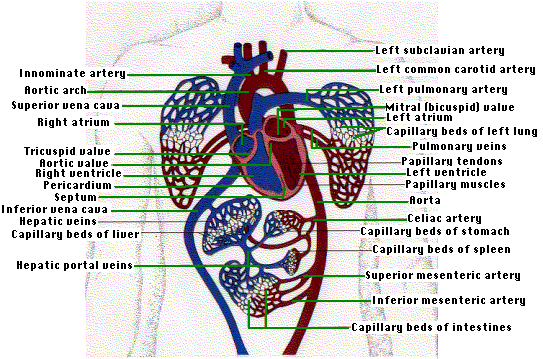The right atrium is the first chamber of the heart that blood flows through. Start studying trace the path of blood through the circulatory system.
 Draw The Pathway Of Blood Flow Through The Circulatory System Of A Mammal Label In Your Pathway Lungs Tissues Left And Right Ventricles Systemic And Pulmonary Circuits Left And Right Atria Tri
Draw The Pathway Of Blood Flow Through The Circulatory System Of A Mammal Label In Your Pathway Lungs Tissues Left And Right Ventricles Systemic And Pulmonary Circuits Left And Right Atria Tri
The human heart consists of four chambers two ventricles and two auricles.

Path of blood through the circulatory system. Blood travels from the left ventricle through this valve heading to the aorta. Blood circulates through the capillaries in the lungs and gathers oxygen in the process. From the arteriosus the blood enters the ventral artery which takes it to the gills where it loses CO 2 and gains O 2 before heading out to the body through the dorsal artery.
1 body 2 inferiorsuperior vena cava 3 right atrium 4 tricuspid valve 5 right ventricle 6 pulmonary arteries 7 lungs 8 pulmonary veins 9 left atrium 10 mitral or bicuspid valve 11 left ventricle 12 aortic valve 13 aorta 14 body. Learn vocabulary terms and more with flashcards games and other study tools. From the tissue capillaries the deoxygenated blood returns through a system of veins to the right atrium of the heart.
This blood is circulated from the aorta to the rest of the body by various major and minor arteries. At the bottom of the right. Systemic circulation carries oxygenated blood from the left ventricle through the arteries to the capillaries in the tissues of the body.
The human circulatory system circulates blood through two loops double circulation One for oxygenated blood another for deoxygenated blood. The systemic circuit is the path of circulation between the heart and the rest of the body excluding the lungs. Blood vessels that take blood away from the heart are arteries.
The human circulatory system consists of blood heart blood vessels and lymph. The circulatory system also called the cardiovascular system is the body system that moves blood around the body. Cardiac output is a measure of _____ the volume of blood per minute pumped from the left ventricle.
What is the path blood takes in the circulatory system. The Path of Blood through the Human Body The Path of Blood through the Human Body When a heart contracts and forces blood into the blood vessels there is a certain path that the blood follows through the human body. The human circulatory system is a double circulatory.
Then it flows on through the pulmonary vein into the left atrium of the heart. Blood flows through the heart in the following order. Blood is pumped from the left ventricle of the heart through the aorta and arterial branches to the arterioles and through capillaries where it reaches an equilibrium with the tissue fluid and then drains through the venules into the veins and returns via the venae cavae to the right atrium of the heart.
Right ventricle lungs left atrium left ventricle body right atrium. As shown in the image above there are actually two circulatory systems in the body. Path of Blood Through the Heart The circulatory system also called the cardiovascular system is responsible for distributing nutrients and oxygen to different parts of the body with the heart working as the pump.
Systemic and Pulmonary Circulation. After moving through the pulmonary circuit oxygen-rich blood in the left ventricle leaves the heart via the aorta. Blood circulation begins when the heart relaxes between heart beats.
Various branch arteries supply the muscles and different organs of the body through a network of ever finer capillaries. The blood carries various materials that the body needs and takes away waste or harmful substances. The blood moves through pulmonary circulation and then continues on through systemic circulation.
At the very same time blood from the bodys organs and muscles that has been deoxygenated flows through the vena cava. Which of the following correctly traces the path of blood through the circulatory system. The journey that follows the path of blood through our heart and body begins with the vena cava.
The coronary arteries are the only vessels that branch from the ascending aorta. The circulatory system Blood is pumped away from the heart at high pressure in arteries and returns to the heart at low pressure in veins. We would like to show you a description here but the site wont allow us.
The Path of blood through the Circulatory System. It consists of the heart and blood vessels. Heart valves function to _____.
The vena cava is comprised of three large veins. Structures of the Circulatory System 1.